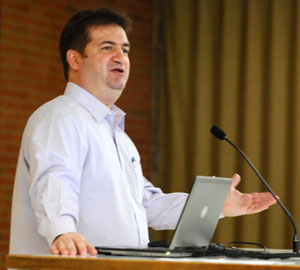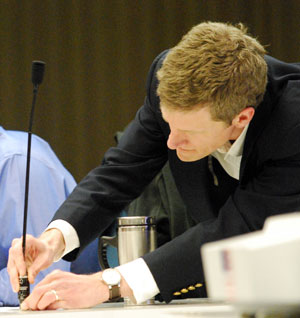City Starts Thinking About Counting Carbon

Alfredo Nicastro, vice president of MGM International, described a cap-and-trade system for carbon emissions at the March 26 meeting of the Ann Arbor environmental commission.
At last Thursday’s regular meeting of the Ann Arbor environmental commission, Alfredo Nicastro of MGM International gave a sales presentation for his company’s services – which served an educational opportunity about carbon credits, and the possibility of the future “compliance market” in the U.S. based on a cap-and-trade system. It was also an opportunity for environmental commissioners to start thinking about the impact of such a market system on the city of Ann Arbor.
In broad strokes, here’s how a cap-and-trade system for carbon emissions – greenhouse gases – might work. The U.S. would set an overall limit – a cap – on the amount of a gas that can be emitted. Companies and other organizations, including entities like the city of Ann Arbor, would be issued permits (allowances, or credits) to emit a certain amount of carbon. The sum of all the emissions allowed by the permits would not exceed the amount specified in the cap. All organizations would have to comply with the requirement that they hold emission allowances at least equal to the amount of carbon they emit.
What if an organization had actual emissions greater than its credits? That organization would have two choices: (i) reduce its emissions, and (ii) purchase credits from some organization that had more credits than it needed in order to be compliant. This transfer of credits is the “trade” in the phrase cap-and-trade. Thus, in a cap-and-trade system, emissions represent a financial risk.
The potential liability that emissions represent in a cap-and-trade system were a theme that Nicastro stressed throughout his presentation. But he also stressed that it was important to think about credits not just as something that might need to be purchased, but as something that could be used as an asset. For example, if an organization like the city of Ann Arbor could achieve reductions in emissions below the levels allowed by its credits, the excess credits would represent value – value that could be converted to cash.
But why does anyone think that such a cap-and-trade system is coming to the U.S.? As Nicastro pointed out several times, it’s because Barack Obama has indicated that the U.S. will reverse the policy of the Bush administration, which in March 2001 withdrew the U.S. from the Kyoto treaty, an agreement which includes an international cap-and-trade protocol.

Kirk Westphal is not looking for carbon credits under the base of this microphone. Westphal is a member of the Ann Arbor environmental commission.
And Nicastro pointed out that even without the Kyoto protocol in place, there was already some impetus for organizations to start thinking about taking inventory of their carbon emissions. For example, the Environmental Protection Agency has proposed regulations that would require various kinds of facilities that emit over 25,000 tons of carbon dioxide equivalent per year to measure and report their emissions.
Among the facility types are waste water treatment facilities. City council recently authorized issuing revenue bonds (not general obligation bonds) for the refurbishing and reconstruction of the city’s waste water treatment facility. In a phone conversation following the environmental commission’s meeting, Matt Naud, environmental coordinator for the city, said that he was uncertain if the city’s waste water treatment facilty emitted more than 25,000 tons of carbon dioxide equivalent per year.
But Naud provided some context for how those emissions might be balanced against possible “credits” due to efforts to reduce emissions of carbon dioxide equivalent. The city’s recycling program between 1991 to 2001, he said, had saved the equivalent of 367,522 metric tons of carbon dioxide emissions.
Naud also pointed us to the city website’s documentation of the landfill gas collection system. That facility emits greenhouse gases (methane and carbon dioxide) through the natural decomposition of waste. The city collects the gas and uses it as fuel in V-8 engines, which are used to generate electricity. From September 1996 through December 2005, the landfill project has eliminated the equivalent of 623,800 tons of carbon dioxide that would have otherwise gone into the atmosphere.
One point that Naud raised in connection with the implementation of a cap-and-trade system was how crucial the drawing of the “bright line” would be – the point in time that determines which projects count for an award of carbon credits. Take the landfill gas collection project, for example. If the cap-and-trade bright line is drawn after before September 1996, when the landfill gas project was first lit, then those carbon dioxide savings could count towards the city’s credits. If the line is drawn after that, then the project would not be considered a savings, but rather a reflection of the baseline starting point.
The landfill gas collection, as well as the recycling program, are projects that the city has embarked on for reasons independent of a cap-and-trade system. Another initiative that falls into the same category is the greenbelt program, which was a millage passed to fund land purchases around and in the city in an effort to preserve open space.
When Nicastro described how land-use projects involving re-forestation (think Amazon jungle) could earn carbon credits, it prompted Carsten Hohnke, one of two city council representatives to the environmental commission, to ask if there were any restrictions on the type of land use in such projects. What about farmland, for example? Nicastro described a grassland reclamation project involving 3,000 alpacas that had earned carbon credits, and allowed the possibility that farmland could qualify as a project. Hohnke confirmed after the meeting that the greenbelt program was exactly what he had in mind when he asked the question.
For readers curious about what kind of carbon emissions they personally generate, the EPA provides a quick carbon calculator. It’s based on home heating and vehicle miles driven. Inputting 1 mile per year driven in a car that gets 1 mile per gallon is calculated by this device at 20 pounds of carbon. Otherwise put, each gallon of gasoline burned puts 20 pounds of carbon dioxide equivalent into the atomosphere.



